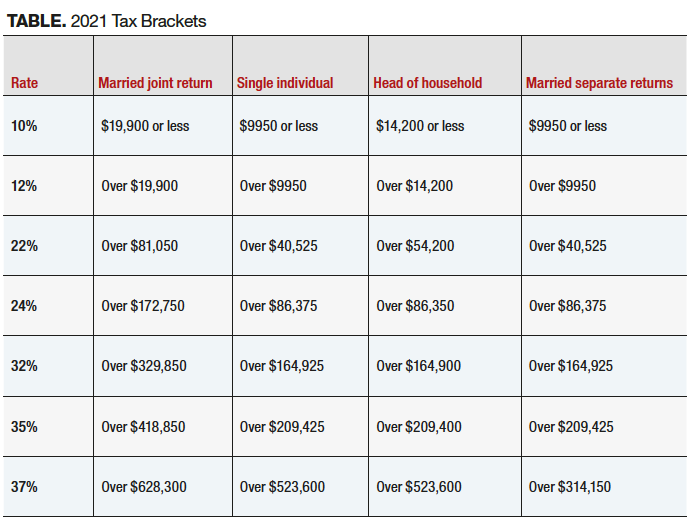Publication
Article
Urology Times Journal
Tax code in 2021: Take note of these changes
Author(s):
Among the changes are increases in phase-out ranges for traditional and Roth IRAs.
Are there any significant tax changes for 2021?
Each year, the Internal Revenue Service (IRS) announces adjustments to
Jeff Witz, CFP

the tax code for the upcoming year. The IRS has not made any significant changes so far, but the agency did make some notable adjustments. Also keep in mind that with a new president-elect and a potential change in the makeup of Congress, the current tax code could be altered again. However, until that time, it is important to stay familiar with the current rules.
In this article, I will discuss some of the important adjustments made by the IRS for 2021.
Notable 2021 adjustments
The standard deduction increased from $24,800 to $25,100 for married couples who file jointly and increased by $150 to $12,550 for single filers and those married but filing separately. Head of households also get a $150 increase to $18,800 in their standard deduction.

Tax rates remained the same, but the brackets increased slightly (Table). Likewise, the capital gains rates remained the same, but the income bracket that determines the rate paid increased. Single filers and married filing separately earning $40,400 per year or less will pay a 0% capital gains rate; married filing jointly earning $80,800 or less and head of households earning $54,100 or less will also pay a 0% taxable gains rate. The 15% rate will apply to adjusted net capital gains up to $501,600 for joint returns, $250,800 for married individuals’ separate returns, $473,750 for head-of-household returns, and $445,850 for single individual returns. For any earnings above these amounts, the applicable capital gains rate is set at 20%.
The maximum contribution amounts into employer-provided retirement plans, such as 401(k)s, 403(b)s, and 457 plans, and the federal government’s Thrift Savings Plan did not change. The limit remains at $19,500, and the catch-up contribution for employees 50 years and older continues to be $6500. For SIMPLE (Savings Incentive Match Plan for Employees) retirement accounts, the contribution limit remains $13,500 and the catchup remains $3,000.
The limit on annual contributions into an individual retirement account (IRA) for pretax, Roth, or a combination remains at $6000 for 2021. The catch-up contribution limit remains at $1000. The deduction for taxpayers making contributions to a traditional IRA is phased out for singles and heads of household who are covered by a workplace retirement plan and have modified adjusted gross incomes (AGI) between $66,000 and $76,000, up from $65,000 and $75,000 in 2020. For married couples filing jointly, in which the spouse who makes the IRA contribution is covered by a workplace retirement plan, the income phase-out range is from $105,000 to $125,000 for 2021, up from $104,000 to $124,000. For an IRA contributor who is not covered by a workplace retirement plan but is married to someone who is covered, the deduction is phased out if the couple’s income is between $198,000 and $208,000 in 2021, up from $196,000 to $206,000 in 2020.
The Roth IRA AGI phase-out range increased to $198,000 to $208,000 for married couples filing jointly, up from $196,000 to $206,000 in 2020. For singles and heads of household, the income phase-out range is from $125,000 to $140,000, up from $124,000 to $139,000 in 2020. If your income exceeds these amounts, you can open a nondeductible IRA and convert it to a Roth IRA.
The income limit for the saver’s credit is $66,000 for married couples filing jointly, $49,500 for heads of household, and $33,000 for singles and married filing separately, up from $32,500.
The IRS made additional changes to the individual tax credit, alternative minimum tax, and allowances for fringe benefits, medical savings accounts, and estates.
Also remember that the special tax provisions enacted as part of the coronavirus relief bill expired at the end of 2020 (unless reenacted by new legislation). These rules offered more flexibility for certain distributions and loans from retirement plans and waived required minimum distributions.
200 North LaSalle Street - Suite 2300 - Chicago, Illinois 60601
312-419-3733 - Toll Free 800-883-8555 - Fax 312-332-4908 - www.mediqus.com
Investment advisory services offered through MEDIQUS Asset Advisors, Inc. Securities offered through Ausdal Financial Partners, Inc.Member FINRA/SIPC ∙ 5187 Utica Ridge Rd ∙ Davenport, IA 52807 ∙ 563-326-2064 ∙ MEDIQUS Asset Advisors and Ausdal Financial Partners, Inc. are independently owned and operated.
Effective June 21, 2005, newly issued Internal Revenue Service regulations require that certain types of written advice include a disclaimer. To the extent the preceding message contains written advice relating to a Federal tax issue, the written advice is not intended or written to be used, and it cannot be used by the recipient or any other taxpayer, for the purposes of avoiding Federal tax penalties, and was not written to support the promotion or marketing of the transaction or matters discussed herein.
The information contained in this report is for informational purposes only. Any calculations have been made using techniques we consider reliable but are not guaranteed. Please contact your tax advisor to review this information and to consult with them regarding any questions you may have with respect to this communication.














